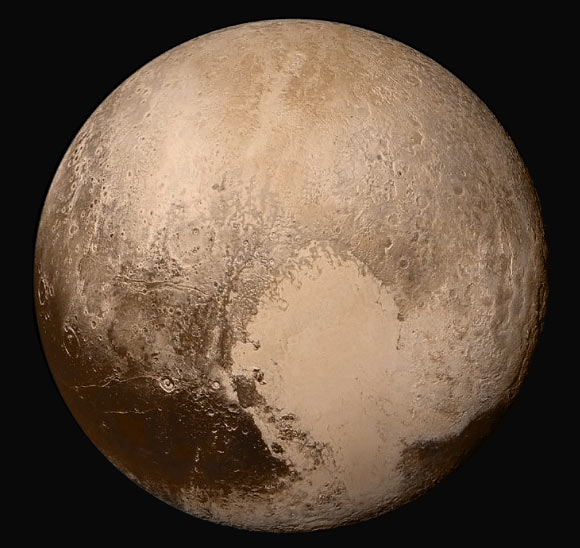Researchers at Southwest Research Institute are studying the data collected by NASA’s New Horizons spacecraft to discover what is pumping up the nitrogen in the atmosphere of Pluto, even as it escapes into interplanetary space.

This mosaic provides the best view ever obtained of the dwarf planet Pluto. The lower right edge of the planet in this view currently lacks high-resolution color coverage. Image credit: NASA / Johns Hopkins University Applied Physics Laboratory / Southwest Research Institute.
The latest New Horizons data reveal an atmosphere dominated by nitrogen gas. However, Pluto’s small mass allows hundreds of tons of atmospheric nitrogen to escape into space each hour.
So where does all this nitrogen come from? Dr Alan Stern and Dr Kelsi Singer outlined likely sources in a paper published online in the Astrophysical Journal Letters (arXiv.org preprint).
“More nitrogen has to come from somewhere to resupply both the nitrogen ice that is moving around Pluto’s surface in seasonal cycles, and the nitrogen that is escaping off the top of the atmosphere as the result of heating by UV light from the Sun,” Dr Singer said.
The scientists looked at a number of different ways that nitrogen might be resupplied.
They wondered if comets could deliver enough nitrogen to the dwarf planet’s surface to resupply what is escaping its atmosphere. They also looked at whether craters made by the comets hitting the surface could excavate enough nitrogen – but that would require a very deep layer of nitrogen ice at the surface, which is not proven.
They also studied whether craters could expose more surface area, by punching through surface deposits that would likely be built up over time.
“We found that all of these effects, which are the major ones from cratering, do not seem to supply enough nitrogen to supply the escaping atmosphere over time. While it’s possible that the escape rate was not as high in the past as it is now, we think geologic activity is helping out by bringing nitrogen up from Pluto’s interior,” Dr Singer said.
And while the data weren’t in before this paper was written, the newest images of the planet show land forms that suggest heat is rising beneath the surface, with troughs of dark matter either collecting, or bubbling up, between flat segments of crust, which could be related.
“Our pre-flyby prediction, made when we submitted the paper, is that it’s most likely that Pluto is actively resupplying nitrogen from its interior to its surface, possibly meaning the presence of ongoing geysers or cryovolcanism. As data from New Horizons comes in, we will be very interested to see if this proves true,” Dr Stern concluded.
_____
Kelsi N. Singer & S. Alan Stern. 2015. On the Provenance of Pluto’s Nitrogen (N2). ApJ 808, L50; doi: 10.1088/2041-8205/808/2/L50







